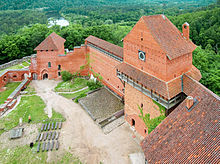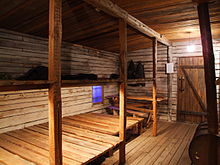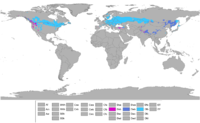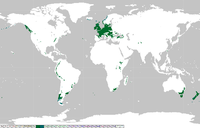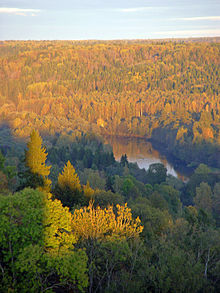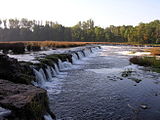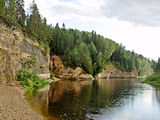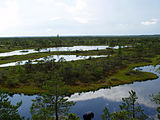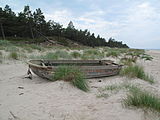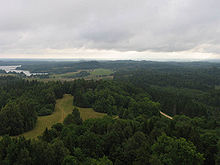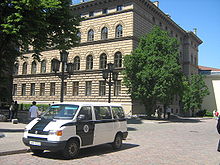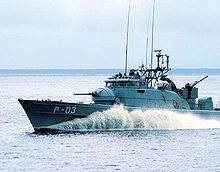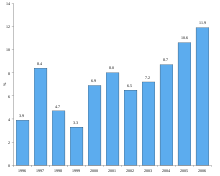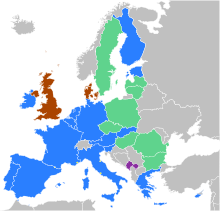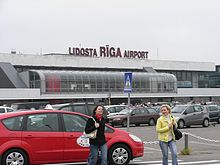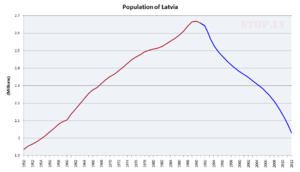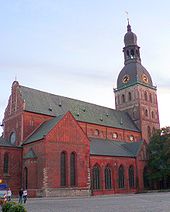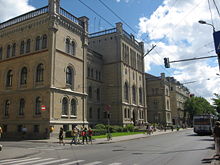
Latvia
Did you know...
This Wikipedia selection is available offline from SOS Children for distribution in the developing world. Click here to find out about child sponsorship.
| Republic of Latvia Latvijas Republika
|
||||||
|---|---|---|---|---|---|---|
|
||||||
| Anthem: Dievs, svētī Latviju! God Bless Latvia! |
||||||
|
Location of Latvia (dark green)
– in Europe (green & dark grey) |
||||||
| Capital and largest city |
Riga 56°57′N 24°6′E |
|||||
| Official languages | Latvian | |||||
| Ethnic groups (2011) | ||||||
| Demonym | Latvian | |||||
| Government | Parliamentary republic | |||||
| - | President | Andris Bērziņš | ||||
| - | Prime Minister | Valdis Dombrovskis | ||||
| Legislature | Saeima | |||||
| Independence from Russia | ||||||
| - | Declareda | November 18, 1918 | ||||
| - | Recognized | January 26, 1921 | ||||
| - | Soviet occupation | August 5, 1940 | ||||
| - | Nazi German occupation | July 10, 1941 | ||||
| - | Soviet re-occupation | 1944 | ||||
| - | Announced independence | May 4, 1990 | ||||
| - | Restored independence | August 21, 1991 | ||||
| Area | ||||||
| - | Total | 64,589 km2 ( 124th) 24,938 sq mi |
||||
| - | Water (%) | 1.57% (1,014 km2) | ||||
| Population | ||||||
| - | 2012 estimate | 2,027,000 ( 146th) | ||||
| - | 2011 census | 2,070,371 | ||||
| - | Density | 34.3/km2 ( 166th) 88.9/sq mi |
||||
| GDP ( PPP) | 2012 estimate | |||||
| - | Total | $37.272 billion | ||||
| - | Per capita | $18,254 | ||||
| GDP (nominal) | 2012 estimate | |||||
| - | Total | $28.380 billion | ||||
| - | Per capita | $13,899 | ||||
| Gini (2010) | 35.2 medium |
|||||
| HDI (2013) | very high · 44th |
|||||
| Currency | Lats (Ls) ( LVL) |
|||||
| Time zone | EET ( UTC+2) | |||||
| - | Summer ( DST) | EEST ( UTC+3) | ||||
| Drives on the | right | |||||
| Calling code | +371 | |||||
| ISO 3166 code | LV | |||||
| Internet TLD | .lv | |||||
| a. | Latvia is de jure continuous with its declaration of November 18, 1918. | |||||
Latvia / ˈ l æ t v i ə / ( Latvian: Latvija), officially the Republic of Latvia ( Latvian: Latvijas Republika), is a country in the Baltic region of Northern Europe. It is bordered to the north by Estonia (border length 343 km), to the south by Lithuania (588 km), to the east by Russia (276 km), and to the southeast by Belarus (141 km), and it shares a maritime border to the west with Sweden. With 2,070,371 inhabitants (population of Latvia peaked at 2.67 million in 1990) and a territory of 64,589 km2 (24,938 sq mi) it is one of the least populous and least densely populated countries of the European Union. The capital of Latvia is Riga. The official language is Latvian and the currency is called Lats (Ls). The country has a temperate seasonal climate.
The Latvians are a Baltic people, culturally related to the Lithuanians. Together with the Finnic Livs (or Livonians), the Latvians are the indigenous people of Latvia. Latvian is an Indo-European language and along with Lithuanian the only two surviving members of the Baltic branch. Indigenous minority languages are Latgalian and the nearly extinct Finnic Livonian language. Despite subjection to foreign rule from the 13th to the 20th centuries, the Latvian nation maintained its identity throughout the generations, most notably the language, culture, and rich musical traditions. Latvia and Estonia share a long common history. Both countries are home to a large number of ethnic Russians (26.9% in Latvia and 25.5% in Estonia) of whom some are non-citizens. Latvia is historically predominantly Protestant, except for the Latgalia region in the southeast, which has historically been predominantly Roman Catholic.
Latvia is a unitary parliamentary republic and is divided into 118 administrative divisions of which 109 are municipalities and 9 are cities. There are five planning regions: Courland (Kurzeme), Latgalia (Latgale), Riga (Rīga), Vidzeme and Zemgale. The Republic of Latvia was founded on November 18, 1918. It was occupied and annexed by the Soviet Union between 1940–1941 and 1945–1991 and by Nazi Germany between 1941–1945. The peaceful " Singing Revolution" between 1987 and 1991 and " Baltic Way" demonstration on August 23, 1989 led to the independence of the Baltic states. Latvia declared the restoration of its de facto independence on August 21, 1991. After economic stagnation in the early 1990s, Latvia posted Europe-leading GDP growth figures during 1998–2006. In the global financial crisis of 2008–2010 Latvia was the hardest hit of the European Union member states, with a GDP decline of 26.54% in that period. Commentators noted signs of stabilisation in the Latvian economy by 2010, and the state of the economy continued to improve, as Latvia once again became one of the fastest growing economies of the EU in 2011.
Latvia is a member of the United Nations, European Union, Council of Europe, NATO, Organization for Security and Co-operation in Europe, International Monetary Fund and World Trade Organization, and is part of the Schengen Area. It was a member of the League of Nations (1921–1946) and the Baltic Free Trade Area (1994–2004). Latvia is also a member of the Council of the Baltic Sea States and Nordic Investment Bank, and is together with Estonia and Lithuania involved in trilateral Baltic States cooperation and Nordic-Baltic cooperation. The United Nations lists Latvia as a country with a "Very High" Human Development Index (HDI).
Etymology
The name Latvija is derived from the name of the ancient Latgalians, one of four Indo-European Baltic tribes (along with Couronians, Selonians and Semigallians) that are the forebears of today's Latvians.
History
Around the beginning of the third millennium BC (3000 BC), the proto-Baltic ancestors of the Latvian people settled on the eastern coast of the Baltic Sea. The Balts established trade routes to Rome and Byzantium, trading local amber for precious metals. By 900 AD, four distinct Baltic tribes inhabited Latvia: Curonians, Latgalians, Selonians, Semigallians (in Latvian: kurši, latgaļi, sēļi and zemgaļi), as well as the Livonians (lībieši) speaking a Finnic language.
The Medieval period
Although the local people had contact with the outside world for centuries, they were more fully integrated into European society in the 12th century. The first missionaries, sent by the Pope, sailed up the Daugava River in the late 12th century, seeking converts. The local people, however, did not convert to Christianity as readily as hoped. German crusaders were sent into Latvia to convert the pagan population by force of arms.
In the beginning of the 13th century, large parts of today's Latvia were ruled by Germans. Together with Southern Estonia, these conquered areas formed the crusader state that became known as Terra Mariana or Livonia. In 1282, Riga, and later the cities of Cēsis, Limbaži, Koknese and Valmiera, were included in the Hanseatic League. Riga became an important point of east-west trading and formed close cultural contacts with Western Europe.
The Reformation period
The 16th, 17th, and 18th centuries were a time of great change for the inhabitants of Latvia, including the reformation, the collapse of the Livonian state, and the time when the Latvian territory was divided up among foreign powers.
After the Livonian War (1558–1583), Livonia (Latvia) fell under Polish and Lithuanian rule. The southern part of Estonia and the northern part of Latvia were ceded to the Grand Duchy of Lithuania and formed into the Ducatus Ultradunensis (Pārdaugavas hercogiste). Gotthard Kettler, the last Master of the Order of Livonia, formed the Duchy of Courland and Semigallia. Though the duchy was a vassal state to Poland, it retained a considerable degree of autonomy and experienced a golden age in the 17th century. Latgalia, the easternmost region of Latvia, became a part of the Polish district of Inflanty.
The 17th and early 18th centuries saw a struggle between the Polish–Lithuanian Commonwealth, Sweden, and Russia for supremacy in the eastern Baltic. After the Polish–Swedish War (1600–1611), northern Livonia (including Vidzeme) came under Swedish rule. Riga became the capital of Swedish Livonia and the largest city in the entire Swedish Empire. Fighting continued sporadically between Sweden and Poland until the Truce of Altmark in 1629. In Latvia, the Swedish period is generally remembered as positive; serfdom was eased, a network of schools was established for the peasantry, and the power of the regional barons was diminished.
Several important cultural changes occurred during this time. Under Swedish and largely German rule, western Latvia adopted Lutheranism as its main religion. The ancient tribes of the Couronians, Semigallians, Selonians, Livs and northern Latgallians assimilated to form the Latvian people, speaking one Latvian language. Throughout all the centuries, however, no such thing as a Latvian state existed so the borders and definitions of who exactly fell within that group are largely subjective. Meanwhile, largely isolated from the rest of Latvia, southern Latgallians adopted Catholicism under Polish/ Jesuit influence. The native dialect remained distinct, although it acquired many Polish and Russian loanwords.
Latvia in the Russian Empire (1710–1917)
The Capitulation of Estonia and Livonia in 1710 and the Treaty of Nystad, ending the Great Northern War in 1721, gave Vidzeme to Russia (it became part of the Riga Governorate). The Latgale region remained part of the Polish–Lithuanian Commonwealth as Inflanty Voivodeship until 1772, when it was incorporated into Russia. The Duchy of Courland and Semigallia became an autonomous Russian province (the Courland Governorate) in 1795, bringing all of what is now Latvia into the Russian Empire. All three Baltic provinces preserved local laws, German as the local official language and their own parliament, the Landtag.
During the Great Northern War (1700–1721), the Baltic area was once again the scene of great devastation, with Peter the Great's scorched-earth policy, famine, and Great Plague of Riga being responsible for catastrophic loss of human life: as much as 40% of the population in Latvian lands were killed. In 1710, the plague reached Riga, where it was active until 1711 and claimed the lives of about half the population.
The promises Peter the Great made to the Baltic German nobility at the fall of Riga in 1710, confirmed by the Treaty of Nystad and known as "the Capitulations", largely reversed the Swedish reforms. Peter seriously considered moving Russian capital into Riga and visited Riga for several long stays (he stayed in his own palace offered as a gift by Riga Magistrate together with keys from Riga; palace purchased by him is still standing; keys are exhibited in Moscow Kremlin museum).
Curiously, Peter the Great's wife Marta (later Catherine I of Russia) was the only Latvian person ever becoming royal.
The emancipation of the serfs took place in Courland in 1817 and in Vidzeme in 1819. In practice, however, the emancipation was actually advantageous to the landowners and nobility, as it dispossessed peasants of their land without compensation, forcing them to return to work at the estates "of their own free will".
During the 19th century, the social structure changed dramatically. A class of independent farmers established itself after reforms allowed the peasants to repurchase their land, but many landless peasants remained. There also developed a growing urban proletariat and an increasingly influential Latvian bourgeoisie. The Young Latvian ( Latvian: Jaunlatvieši) movement laid the groundwork for nationalism from the middle of the century, many of its leaders looking to the Slavophiles for support against the prevailing German-dominated social order. The rise in use of the Latvian language in literature and society became known as the First National Awakening. Russification began in Latgale after the Polish led the January Uprising in 1863: this spread to the rest of what is now Latvia by the 1880s. The Young Latvians were largely eclipsed by the New Current, a broad leftist social and political movement, in the 1890s. Popular discontent exploded in the 1905 Russian Revolution, which took a nationalist character in the Baltic provinces.
During these two centuries Latvia experienced economic and construction boom – ports were expanded (Riga became the largest port in the Russian Empire), railways built; new factories, banks and University were established; many residential, public (theaters and museums) and school buildings erected; new parks formed; etc. Riga's boulevards and streets with beautiful buildings outside the Old Town are dated from this period.
Declaration of Independence
World War I devastated the territory of what would become the state of Latvia, along with other western parts of the Russian Empire. Demands for self-determination were at first confined to autonomy, but the Russian 1917 Revolution, treaty with Germany at Brest-Litovsk, and allied armistice with Germany on November 11, 1918, created a power vacuum. The People's Council of Latvia proclaimed the independence of the new country in Riga on November 18, 1918, with Kārlis Ulmanis becoming the head of the provisional government.
The War of Independence that followed was part of a general chaotic period of civil and new border wars in Eastern Europe. By the spring of 1919, there were actually three governments — Ulmanis' government; the Latvian Soviet government led by Pēteris Stučka, whose forces, supported by the Red Army, occupied almost all of the country; and the Baltic German government of the United Baltic Duchy, headed by Andrievs Niedra and supported by the Baltische Landeswehr and the German Freikorps unit Iron Division.
Estonian and Latvian forces defeated the Germans at the Battle of Wenden in June 1919, and a massive attack by a predominantly German force — the West Russian Volunteer Army — under Pavel Bermondt-Avalov was repelled in November. Eastern Latvia was cleared of Red Army forces by Latvian and Polish troops in early 1920 (from the Polish perspective the Battle of Daugavpils was a part of the Polish-Soviet War).
A freely elected Constituent assembly convened on May 1, 1920, and adopted a liberal constitution, the Satversme, in February 1922. The constitution was partly suspended by Kārlis Ulmanis after his coup in 1934, but reaffirmed in 1990. Since then, it has been amended and is still in effect in Latvia today. With most of Latvia's industrial base evacuated to the interior of Russia in 1915, radical land reform was the central political question for the young state. In 1897, 61.2% of the rural population had been landless; by 1936, that percentage had been reduced to 18%.
By 1923, the extent of cultivated land surpassed the pre-war level. Innovation and rising productivity led to rapid growth of the economy, but it soon suffered from the effects of the Great Depression. Latvia showed signs of economic recovery and the electorate had steadily moved toward the centre during the parliamentary period. On May 15, 1934, Ulmanis staged a bloodless coup, establishing a nationalist dictatorship that lasted until 1940. After 1934, Ulmanis established government corporations to buy up private firms with the aim of "Latvianising" the economy.
Latvia in World War II
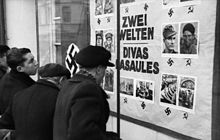
Early in the morning of August 24, 1939, the Soviet Union and Nazi Germany signed a 10-year non-aggression pact, called the Molotov–Ribbentrop Pact. The pact contained a secret protocol, revealed only after Germany's defeat in 1945, according to which the states of Northern and Eastern Europe were divided into German and Soviet " spheres of influence". In the North, Latvia, Finland and Estonia were assigned to the Soviet sphere. Thereafter, Germany and the Soviet union invaded their respective portions of Poland.
After the conclusion of the Molotov-Ribbentrop Pact, most of the Baltic Germans left Latvia by agreement between Ulmanis' government and Nazi Germany under the Heim ins Reich program. In total 50,000 Baltic Germans left by the deadline of December 1939, with 1,600 remaining to conclude business and 13,000 choosing to remain in Latvia. Most of those who remained left for Germany in summer 1940, when a second resettlement scheme was agreed.
On 5 October 1939, Latvia was forced to accept a "mutual assistance" pact with the Soviet Union, granting the Soviets the right to station between 25,000 and 30,000 troops on Latvian territory. After staging border incidents, on 16 June 1940 the government of the USSR handed the Latvian ambassador in Moscow a note, in which Latvia was accused of breaching the articles of the agreement of 5 October 1939, and demands were made for sending in additional Soviet troops and to change the government. The Latvian government capitulated in the face of overwhelming force. On 17 June Soviet troops invaded Latvian territory. In his address by radio, Kārlis Ulmanis announced:
Soviet forces are marching into our land this very morning. This is happening with the knowledge and consent of the government, which in turn stems from the amicable relations that exist between Latvia and the Soviet Union. It is, therefore, my wish that the residents of our country also show friendship towards the advancing military units ... The government has resigned. I shall remain in my place, you remain in yours.
No opposition was shown towards the Soviet forces; on the contrary, part of the population accepted the news of their arrival with enthusiasm, which was heavily exploited by Soviet propaganda. Observing them, the well known Russian lawyer and public figure of Latvia, Pyotr Yakobi, wrote:
Taken from the German model, the authoritarian beginning in our country has turned into a government of national bureaucracy, having satisfied a limited circle of citizens, who have adapted themselves to the state pie. Clearly, any hardship is not in vain. And so now the down-trodden have raised their voice and demand a return of their rights that have been trampled on ...
Those unhappy with the regime of Kārlis Ulmanis included not only the national minorities, but also many Latvians who were anxious about the deteriorating economic situation and had no desire to end up under Nazi German rule.
State administrators were liquidated and replaced by Soviet cadres, in which 34,250 Latvians were deported or killed. Elections were held with single pro-Soviet candidates listed for many positions. The resulting people's assembly immediately requested admission into the USSR, which the Soviet Union granted. Latvia, then a puppet government, was headed by Augusts Kirhenšteins. The Soviet Union incorporated Latvia on August 5, 1940, as The Latvian Soviet Socialist Republic.
The Soviets dealt harshly with their opponents – prior to the German invasion, in less than a year, at least 27,586 people were arrested. Most were deported for cooperating with the German army, and about 945 were shot. Under German occupation, Latvia was administered as part of Reichskommissariat Ostland. Latvian paramilitary and Auxiliary Police units established by the occupation authority participated in the Holocaust as well. More than 200,000 Latvian citizens died during World War II, including approximately 75,000 Latvian Jews murdered during the Nazi occupation. Latvian soldiers fought on both sides of the conflict, including in the Latvian Legion of the Waffen-SS, most of them conscripted by the occupying Nazi and Soviet authorities.
Soviet era (1940 – 1941, 1944 – 1991)
In 1944, when Soviet military advances reached the area, heavy fighting took place in Latvia between German and Soviet troops, which ended in another German defeat. In the course of the war, both occupying forces conscripted Latvians into their armies, in this way increasing the loss of the nation's "live resources". In 1944, part of the Latvian territory once more came under Soviet control. The Soviets immediately began to reinstate the Soviet system. After the German surrender, it became clear that Soviet forces were there to stay, and Latvian national partisans, soon joined by German collaborators, began to fight against the new occupier.
Anywhere from 120,000 to as many as 300,000 Latvians took refuge from the Soviet army by fleeing to Germany and Sweden. Most sources count 200,000 to 250,000 refugees leaving Latvia, with perhaps as many as 80,000 to 100,000 of them recaptured by the Soviets or, during few months immediately after the end of war, returned by the West. The Soviets reoccupied the country in 1944–1945, and further deportations followed as the country was collectivised and Sovieticised.
On March 25, 1949, 43,000 rural residents (" kulaks") and Latvian patriots ("nationalists") were deported to Siberia in a sweeping Operation Priboi in all three Baltic states, which was carefully planned and approved in Moscow already on January 29, 1949. Between 136,000 and 190,000 Latvians, depending on the sources, were imprisoned, repressed or deported to Soviet concentration camps (the Gulag) in the post war years, from 1945 to 1952. Some managed to escape arrest and joined the partisans.
In the post-war period, Latvia was made to adopt Soviet farming methods. Rural areas were forced into collectivisation. An extensive programme to impose bilingualism was initiated in Latvia, limiting the use of Latvian language in official uses in favour of using Russian as the main language. All of the minority schools (Jewish, Polish, Belorussian, Estonian, Lithuanian) were closed down leaving only two media of instructions in the schools: Latvian and Russian. An influx of labourers, administrators, military personnel and their dependents from Russia and other Soviet republics started. By 1959 about 400,000 persons arrived from other Soviet republics and the ethnic Latvian population had fallen to 62%.
Because Latvia had maintained a well-developed infrastructure and educated specialists, Moscow decided to base some of the Soviet Union's most advanced manufacturing in Latvia. New industry was created in Latvia, including a major machinery factory RAF in Jelgava, electrotechnical factories in Riga, chemical factories in Daugavpils, Valmiera and Olaine—and some food and oil processing plants. Latvia manufactured trains, ships, minibuses, mopeds, telephones, radios and hi-fi systems, electrical and diesel engines, textiles, furniture, clothing, bags and luggage, shoes, musical instruments, home appliances, watches, tools and equipment, aviation and agricultural equipment and long list of other goods. Latvia had its own film industry and musical records factory (LPs). However, there were not enough people to operate the newly built factories. To maintain and expand industrial production, skilled workers were migrating from all over the Soviet Union, decreasing the proportion of ethnic Latvians in the republic. Population of Latvia reached its peak in 1990 at just under 2,7 million people.
Restoration of independence in 1991
In the second half of 1980s, Soviet leader Mikhail Gorbachev started to introduce political and economic reforms in the Soviet Union that were called glasnost and Perestroika. In the summer of 1987 the first large demonstrations were held in Riga at the Freedom Monument—a symbol of independence. In the summer of 1988, a national movement, coalescing in the Popular Front of Latvia, was opposed by the Interfront. The Latvian SSR, along with the other Baltic Republics was allowed greater autonomy, and in 1988, the old pre-war Flag of Latvia flew again, replacing the Soviet Latvian flag as the official flag in 1990.
In 1989, the Supreme Soviet of the USSR adopted a resolution on the Occupation of the Baltic states, in which it declared the occupation "not in accordance with law," and not the "will of the Soviet people." Pro-independence Popular Front of Latvia candidates gained a two-thirds majority in the Supreme Council in the March 1990 democratic elections. On May 4, 1990, the Supreme Soviet of the Latvian SSR adopted the Declaration On the Restoration of Independence of the Republic of Latvia, and the Latvian SSR was renamed Republic of Latvia.
However, the central power in Moscow continued to regard Latvia as a Soviet republic in 1990 and 1991. In January 1991, Soviet political and military forces tried unsuccessfully to overthrow the Republic of Latvia authorities by occupying the central publishing house in Riga and establishing a Committee of National Salvation to usurp governmental functions. During the transitional period, Moscow maintained many central Soviet state authorities in Latvia.
In spite of this, 73% of all Latvian residents confirmed their strong support for independence on March 3, 1991, in a nonbinding advisory referendum. A large number of ethnic Russians also voted for the proposition. The Popular Front of Latvia advocated that all permanent residents be eligible for Latvian citizenship. However, universal citizenship for all permanent residents was not adopted. A majority of ethnic non-Latvians did not receive Latvian citizenship, even though they had voted in support of independence. Many of them were born in Latvia, but still became non-citizens. By 2011, more than half of non-citizens had taken naturalization exams and received Latvian citizenship. Still, today there are 290,660 non-citizens in Latvia, which represent 14.1% of population. They have no citizenship of any country, and cannot vote in Latvia. The Republic of Latvia declared the end of the transitional period and restored full independence on August 21, 1991, in the aftermath of the failed Soviet coup attempt.
The Saeima, Latvia's parliament, was again elected in 1993, and Russia completed its military withdrawal in 1994, with troops remaining at the Skrunda-1 station until 1998. The major goals of Latvia in the 1990s, to join NATO and the European Union, were achieved in 2004.
Language and citizenship laws have been opposed by many Russophones. (Citizenship was not automatically extended to former Soviet citizens who settled during the Soviet occupation, or to their offspring. This caused a situation where people who have lived and worked in the Soviet Union for over 50 years were nonetheless unable to vote, partially excluding the ethnic Russian voice from the parliament and the government. Children born to non-nationals after the reestablishment of independence are automatically entitled to citizenship.) Approximately 72% of Latvian citizens are Latvian, while 20% are Russian; less than 1% of non-citizens are Latvian, while 71% are Russian. The government denationalised private property confiscated by the Soviet rule, returning it or compensating the owners for it, and privatised most state-owned industries, reintroducing the prewar currency. Albeit having experienced a difficult transition to a liberal economy and its re-orientation toward Western Europe, its economy had one of the highest growth rates until the 2008–2010 Latvian financial crisis.
Geography
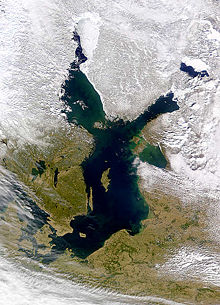
Latvia lies in Northern Europe, on the eastern shores of the Baltic Sea and northwestern part of the East European craton, between latitudes 55° and 58° N (a small area is north of 58°), and longitudes 21° and 29° E (a small area is west of 21°). Latvia has a total area of 64,559 km2 (24,926 sq mi) of which 62,157 km2 (23,999 sq mi) land, 18,159 km2 (7,011 sq mi) agricultural land, 34,964 km2 (13,500 sq mi) forest land and 2,402 km2 (927 sq mi) inland water.
The total length of Latvia's boundary is 1,866 km (1,159 mi). The total length of its land boundary is 1,368 km (850 mi), of which 343 km (213 mi) is shared with Estonia to the north, 276 km (171 mi) with the Russian Federation to the east, 161 km (100 mi) with Belarus to the southeast and 588 km (365 mi) with Lithuania to the south. The total length of its maritime boundary is 498 km (309 mi), which is shared with Estonia, Sweden and Lithuania. Extension from north to south is 210 km (130 mi) and from west to east 450 km (280 mi).
Most of Latvia's territory is less than 100 m (330 ft) above sea level. Its largest lake Lubāns is 80.7 km2 (31.2 sq mi), its deepest lake Drīdzis is 65.1 m (214 ft). The longest river on Latvian territory is the Gauja, 452 km (281 mi). The longest river flowing through Latvian territory is the Daugava, which has a total length 1,005 km (624 mi) of which 352 km (219 mi) on Latvian territory. Latvia's highest point is Gaiziņkalns, 311.6 m (1,022 ft). The length of Latvia's Baltic coastline is 494 km (307 mi). An inlet of the Baltic Sea, the shallow Gulf of Riga is situated in the northwest of the country.
Climate
Latvia has a temperate climate that has been described in various sources as either humid continental ( Köppen Dfb) or oceanic/maritime (Köppen Cfb.)
Coastal regions, especially the western coast of Courland Peninsula, possess a more maritime climate with cooler summers and milder winters, while eastern parts exhibit a more continental climate with warmer summers and harsher winters. Daugavpils in southeastern Latvia has been the site for both the lowest and highest temperatures ever recorded.
Latvia has four pronounced seasons of near-equal length. Winter starts in mid-December and lasts until mid-March. Winters have average temperatures of −6 °C (21 °F) and are characterized by stable snow cover, bright sunshine, and short days. Severe spells of winter weather with cold winds, extreme temperatures of around −30 °C (−22 °F) and heavy snowfalls are common. Summer starts in June and lasts until August. Summers are usually warm and sunny, with cool evenings and nights. Summers have average temperatures of around 19 °C (66 °F), with extremes of 35 °C (95 °F). Spring and autumn bring fairly mild weather.
|
Average temperatures in Latvia in 2011
|
||||||||||||
|
Month
|
Jan
|
Feb
|
Mar
|
Apr
|
May
|
Jun
|
Jul
|
Aug
|
Sep
|
Oct
|
Nov
|
Dec
|
|
Average temperatures (°C)
|
-3.0
|
-8.9
|
-0.5
|
+6.8
|
+11.2
|
+17.3
|
+19.8
|
+16.8
|
+13.4
|
+7.8
|
+4.4
|
+2.1
|
| Weather record | Value | Location | Date |
|---|---|---|---|
| Highest t° | 36.4 °C (98 °F) | Daugavpils | August 28, 1943 |
| Lowest t° | −43.2 °C (−46 °F) | Daugavpils | February 8, 1956 |
| Last spring frost | – | large parts of territory | June 24, 1982 |
| First fall frost | – | Cenas parish | August 15, 1975 |
| Highest yearly precipitation | 1007 mm | Priekuļi parish | 1928 |
| Lowest yearly precipitation | 384 mm | Ainaži | 1939 |
| Highest daily precipitation | 160 mm | Ventspils | July 9, 1973 |
| Highest monthly precipitation | 330 mm | Nīca parish | August 1972 |
| Lowest monthly precipitation | 0 mm | large parts of territory | May 1938 and May 1941 |
| Thickest snow cover | 126 cm | Gaiziņkalns | March 1931 |
| Month with the most days with blizzards | 19 days | Liepāja | February 1956 |
| The most days with fog in a year | 143 days | Gaiziņkalns area | 1946 |
| Longest lasting fog | 93 hours | Alūksne | 1958 |
| Highest atmospheric pressure | 799.5 mm Hg | Liepāja | January 1907 |
| Lowest atmospheric pressure | 699.7 mm Hg | Vidzeme Upland | February 13, 1962 |
| The most days with thunderstorms in a year | 52 days | Vidzeme Upland | 1954 |
| Strongest wind | 34 m/s, up to 48 m/s | not specified | November 2, 1969 |
Environment
Most of the country is composed of fertile lowland plains and moderate hills. In a typical Latvian landscape, a mosaic of vast forests alternates with fields, farmsteads, and pastures. Arable is spotted with birch groves and wooded clusters, which afford a habitat for numerous plants and animals. Latvia has hundreds of kilometres of undeveloped seashore—lined by pine forests, dunes, and continuous white sand beaches.
Latvia has the 4th highest proportion of land covered by forests in the European Union, after Finland, Sweden and Slovenia. Forests account for 3,497,000 ha (8,640,000 acres) or 56% of the total land area.
Latvia has over 12,500 rivers, which stretch for 38,000 km (24,000 mi). Major rivers include the Daugava River, Lielupe, Gauja, Venta, and Salaca, the largest spawning ground for salmon in the eastern Baltics. There are 2,256 lakes that are bigger than 1 ha (2.5 acres), with a collective area of 1,000 km2 (390 sq mi). Mires occupy 9.9% of Latvia's territory. Of these, 42% are raised bogs; 49% are fens; and 9% are transitional mires. 70% percent of the mires are untouched by civilisation, and they are a refuge for many rare species of plants and animals.
Agricultural areas account for 1,815,900 ha (4,487,000 acres) or 29% of the total land area. With the dismantling of collective farms, the area devoted to farming decreased dramatically – now farms are predominantly small. Approximately 200 farms, occupying 2,750 ha (6,800 acres), are engaged in ecologically pure farming (i.e., using no artificial fertilizers or pesticides).
Latvia's national parks are Gauja National Park in Vidzeme (since 1973), Ķemeri National Park in Zemgale (1997), Slītere National Park in Kurzeme (1999) and Rāzna National Park in Latgale (2007).
Latvia has a long tradition of conservation. The first laws and regulations were promulgated in the 16th and 17th centuries. There are 706 specially state-level protected natural areas in Latvia, of which: 4 national parks, 1 biosphere reserve, 42 nature parks, 9 areas of protected landscapes, 260 nature reserves, 4 strict nature reserves, 355 nature monuments, 7 protected marine areas and 24 microreserves. Nationally protected areas account for 12,790 km2 (4,940 sq mi) or around 20% of Latvia's total land area. Latvia's Red Book (Endangered Species List of Latvia), which was established in 1977, contains 112 plant species and 119 animal species. Latvia has ratified the international Washington, Bern, and Ramsare conventions.
The 2012 Environmental Performance Index ranks Latvia 2nd after Switzerland, based on the environmental performance of the country's policies.
|
Biodiversity

Approximately 27,700 species of flora and fauna have been registered in Latvia. Common species of wildlife in Latvia include deer, wild boar, moose, lynx, bear, fox, beaver and wolves. Non-marine molluscs of Latvia include 159 species.
Species that are endangered in other European countries but common in Latvia include: black stork ( Ciconia nigra), corncrake ( Crex crex), lesser spotted eagle ( Aquila pomarina), white-backed woodpecker ( Picoides leucotos), crane ( Grus grus), Eurasian beaver ( Castor fibre), Eurasian otter ( Lutra lutra), European wolf (Canis lupus), and the European lynx ( Felis lynx).
Phytogeographically, Latvia is shared between the Central European and Northern European provinces of the Circumboreal Region within the Boreal Kingdom. According to the WWF, the territory of Latvia belongs to the ecoregion of Sarmatic mixed forests. More than half of Latvia's territory is covered by forests, mostly Scots Pine, birch and Norway Spruce.
Several species of flora and fauna are considered national symbols. Oak (Quercus robur, Latvian: ozols), and linden (Tilia cordata, Latvian: liepa) are Latvia's national trees and the daisy (Leucanthemum vulgare, Latvian: pīpene) its national flower. The white wagtail (Motacilla alba, Latvian: baltā cielava) is Latvia's national bird. Its national insect is the Two-spot Ladybird (Adalia bipunctata, Latvian: mārīte). Amber, fossilized tree resin, is one of Latvia's most important cultural symbols. In ancient times, amber found along the Baltic Sea coast was sought by Vikings as well as traders from Egypt, Greece and the Roman Empire. This led to the development of the Amber Road.
Regions and divisions
Latvia is a unitary state, currently divided into 110 one-level municipalities ( Latvian: novadi) and 9 republican cities ( Latvian: republikas pilsētas) with their own city council and administration: Daugavpils, Jēkabpils, Jelgava, Jūrmala, Liepāja, Rēzekne, Riga, Valmiera and Ventspils. There are four historical and cultural regions in Latvia – Courland, Latgale, Vidzeme, Zemgale, which are recognised in Constitution of Latvia. Selonia, a part of Zemgale, is sometimes considered culturaly distinct region, but it is not part of any formal division. The borders of historical and cultural regions usually are not explicit definite and in several sources may vary. In formal divisions Riga region, which includes capital and parts of other regions that have strong relationship to capital, is also often included in regional divisions e.g. there are five planning regions of Latvia ( Latvian: plānošanas reģioni), which were created in 2009 to promote balanced development of all regions, under this division Riga region includes large parts of what traditionally is considered Vidzeme, Courland and Zemgale. Statistical regions of Latvia, established in accordance with EU Nomenclature of Territorial Units for Statistics, duplicate this division, but divides Riga region into two parts with capital alone being a separate region.
Politics
The 100-seat unicameral Latvian parliament, the Saeima, is elected by direct popular vote every four years. The president is elected by the Saeima in a separate election, also held every four years. The president appoints a prime minister who, together with his cabinet, forms the executive branch of the government, which has to receive a confidence vote by the Saeima. This system also existed before World War II. Highest civil servants are sixteen Secretaries of State.
Foreign relations
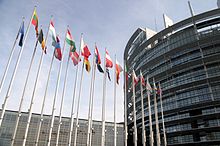

Latvia is a member of the United Nations, European Union, Council of Europe, NATO, Organization for Security and Co-operation in Europe, International Monetary Fund and World Trade Organization. It was a member of the League of Nations (1921–1946). Latvia is also a member of the Council of the Baltic Sea States and Nordic Investment Bank.
Latvia has established diplomatic relations with 158 countries and maintains embassies in 35 countries. 37 countries maintain an embassy in Latvia's capital Riga. Latvia hosts one European Union institution, the Body of European Regulators for Electronic Communications (BEREC).
Latvia’s foreign policy priorities include co-operation in the Baltic Sea region, European integration, active involvement in international organisations, contribution to European and transatlantic security and defence structures, participation in international civilian and military peacekeeping operations, and development co-operation, particularly the strengthening of stability and democracy in the EU's Eastern neighbours.
Since the early 1990s, Latvia is involved in active trilateral Baltic states co-operation with its neighbours Estonia and Lithuania, and Nordic-Baltic co-operation with the Nordic countries. The Baltic Council is the joint forum of the interparliamentary Baltic Assembly (BA) and the intergovernmental Baltic Council of Ministers (BCM). Nordic-Baltic Eight (NB-8) is the joint co-operation of the governments of Denmark, Estonia, Finland, Iceland, Latvia, Lithuania, Norway and Sweden. Nordic-Baltic Six (NB-6), comprising Nordic-Baltic countries that are European Union member states, is a framework for meetings on EU-related issues. Interparliamentary co-operation between the Baltic Assembly and Nordic Council was signed in 1992 and since 2006 annual meetings are held as well as regular meetings on other levels. Joint Nordic-Baltic projects include the education programme Nordplus.
The Enhanced Partnership in Northern Europe or e-Pine is the U.S. Department of State diplomatic framework for co-operation with the Nordic-Baltic countries. In 2013 Riga will host the annual Northern Future Forum, a two-day informal meeting of the prime ministers of the Nordic-Baltic countries and the UK. The Northern Dimension and Baltic Sea Region Programme are European Union initiatives for cross-border co-operation in the Baltic Sea region and Northern Europe.
Latvia hosted the 2006 NATO Summit and since the annual Riga Conference has become a leading foreign and security policy forum in Northern Europe. Latvia will hold the Presidency of the Council of the European Union in the first half of 2015.
Human rights
According to the reports by Freedom House and the US Department of State, human rights in Latvia are generally respected by the government: Latvia is ranked above-average among the world's sovereign states in democracy, press freedom, privacy and human development.
On the other hand, human rights organisations have reported multiple problems.
The country has a large ethnic Russian community, which was guaranteed basic rights under the constitution and international human rights laws ratified by the Latvian government. Non-citizens – including stateless persons – have limited access to some political rights – only citizens are allowed to participate in parliamentary or municipal elections, although there are no limitations in regards to joining political parties or other political organizations. Additionally, there have been reports of police abuse of detainees and arrestees, poor prison conditions and overcrowding, judicial corruption, discrimination against women, incidents of violence against ethnic minorities, and societal violence and incidents of government discrimination against homosexuals.
Military
The National Armed Forces (Latvian: Nacionālie Bruņotie Spēki (NAF)) of Latvia consists of the Land Forces, Naval Forces, Air Force, National Guard, Special Tasks Unit, Military Police, NAF Staff Battalion, Training and Doctrine Command and Logistics Command. Latvia's defence concept is based upon the Swedish-Finnish model of a rapid response force composed of a mobilization base and a small group of career professionals. From January 1, 2007 Latvia has switched to a professional fully contract-based army.
Latvia participates in international peacekeeping and security operations. Latvian armed forces have contributed to NATO and EU military operations in Bosnia and Herzegovina (1996–2009), Albania (1999), Kosovo (2000–2009), Macedonia (2003), Iraq (2005–2006), Afghanistan (since 2003) and Somalia (since 2011). Latvia also took part in the US-led Multi-National Force operation in Iraq (2003–2008) and OSCE missions in Georgia, Kosovo and Macedonia. Latvian armed forces will contribute to a UK-led Battlegroup in 2013 and the Nordic Battlegroup in 2015 under the Common Security and Defence Policy (CSDP) of the European Union. Latvia acts as the lead nation in the coordination of the Northern Distribution Network for transportation of non-lethal ISAF cargo by air and rail to Afghanistan. It is part of the Nordic Transition Support Unit (NTSU), which renders joint force contributions in support of Afghan security structures ahead of the withdrawal of Nordic and Baltic ISAF forces in 2014. Since 1996 more than 3600 military personnel have participated in international operations, of whom 7 soldiers perished. Per capita, Latvia is one of the largest contributors to international military operations.
Latvian civilian experts have contributed to EU civilian missions: border assistance mission to Moldova and Ukraine (2005–2009), rule of law missions in Iraq (2006 and 2007) and Kosovo (since 2008), police mission in Afghanistan (since 2007) and monitoring mission in Georgia (since 2008).
Since March 2004, when the Baltic states joined NATO, fighter jets of NATO members are on rotational basis deployed for the Baltic Air Policing mission at Šiauliai Airport in Lithuania to guard the Baltic airspace. Latvia is a founding member of the NATO Cooperative Cyber Defence Centre of Excellence in Tallinn, Estonia and the NATO Energy Security Centre of Excellence in Vilnius, Lithuania.
Latvia co-operates with Estonia and Lithuania in several trilateral Baltic defence co-operation initiatives:
- Baltic Battalion (BALTBAT) – infantry battalion for participation in international peace support operations, headquartered near Riga, Latvia;
- Baltic Naval Squadron (BALTRON) – naval force with mine countermeasures capabilities, headquartered near Tallinn, Estonia;
- Baltic Air Surveillance Network (BALTNET) – air surveillance information system, headquartered near Kaunas, Lithuania;
- Joint military educational institutions: Baltic Defence College in Tartu, Estonia, Baltic Diving Training Centre in Liepāja, Latvia and Baltic Naval Communications Training Centre in Tallinn, Estonia.
Future co-operation will include sharing of national infrastructures for training purposes and specialisation of training areas (BALTTRAIN) and collective formation of battalion-sized contingents for use in the NATO rapid-response force. In January 2011, the Baltic states were invited to join NORDEFCO, the defence framework of the Nordic countries. In November 2012, the three countries agreed to create a joint military staff in 2013.
Economy
Latvia is a member of the World Trade Organization (1999) and the European Union (2004).
Since the year 2000 Latvia has had one of the highest (GDP) growth rates in Europe. However, the chiefly consumption-driven growth in Latvia resulted in the collapse of the Latvian GDP in late 2008 and early 2009, exacerbated by the global economic crisis and shortage of credit. Latvian economy fell 18% in the first three months of 2009, the biggest fall in the European Union. According to Eurostat data, Latvian PPS GDP per capita stood at 56 per cent of the EU average in 2008.
This latest scenario has proven the earlier assumptions that the fast growing economy was heading for implosion of the economic bubble, because it was driven mainly by growth of domestic consumption, financed by a serious increase of private debt, as well as a negative foreign trade balance. The prices of real estate, which were at some points appreciating at approximately 5% a month, were long perceived to be too high for the economy, which mainly produces low-value goods and raw materials.
Latvia plans to introduce the Euro as the country's currency but, due to the inflation being above EMU's guidelines, the government's official target is now January 1, 2014.
Privatization in Latvia is almost complete. Virtually all of the previously state-owned small and medium companies have been privatized, leaving only a small number of politically sensitive large state companies. The private sector accounted for nearly 68% of the country's GDP in 2000.
Foreign investment in Latvia is still modest compared with the levels in north-central Europe. A law expanding the scope for selling land, including to foreigners, was passed in 1997. Representing 10.2% of Latvia's total foreign direct investment, American companies invested $127 million in 1999. In the same year, the United States exported $58.2 million of goods and services to Latvia and imported $87.9 million. Eager to join Western economic institutions like the World Trade Organization, OECD, and the European Union, Latvia signed a Europe Agreement with the EU in 1995—with a 4-year transition period. Latvia and the United States have signed treaties on investment, trade, and intellectual property protection and avoidance of double taxation.
Economic contraction and recovery (2008–2012)
The Latvian economy entered a phase of fiscal contraction during the second half of 2008 after an extended period of credit-based speculation and unrealistic appreciation in real estate values. The national account deficit for 2007, for example, represented more than 22% of the GDP for the year while inflation was running at 10%.
Latvia's unemployment rate rose sharply in this period from a low of 5.4% in November 2007 to over 22%. In April 2010 Latvia had the highest unemployment rate in the EU, at 22.5%, ahead of Spain, which had 19.7%.
Paul Krugman, the Nobel Laureate in economics for 2008, wrote in his New York Times Op-Ed column for December 15, 2008:
- "The most acute problems are on Europe’s periphery, where many smaller economies are experiencing crises strongly reminiscent of past crises in Latin America and Asia: Latvia is the new Argentina "
However by 2010 commentators noted signs of stabilisation in the Latvian economy. Rating agency Standard & Poor's raised its outlook on Latvia's debt from negative to stable. Latvia's current account, which had been in deficit by 27% in late 2006 was in surplus in February 2010. Kenneth Orchard, senior analyst at Moody's investors service argued that:
- "The strengthening regional economy is supporting Latvian production and exports, while the sharp swing in the current account balance suggests that the country’s ‘internal devaluation’ is working."
The IMF concluded the First Post-Program Monitoring Discussions with the Republic of Latvia in July 2012 announcing that Latvia’s economy has been recovering strongly since 2010, following the deep downturn in 2008–09. Real GDP growth of 5.5 percent in 2011 was underpinned by export growth and a recovery in domestic demand. The growth momentum has continued into 2012 despite deteriorating external conditions, and the economy is expected to expand by 3.5 percent. The unemployment rate has receded from its peak of more than 20 percent in 2010, but remains high at more than 16 percent in 2012.
Infrastructure
The transport sector is around 14% of GDP. Transit between Russia and the West is large.
Key ports are in Riga, Ventspils, and Liepāja. Most transit traffic uses these and half the cargo is crude oil and oil products.
Riga International Airport is the busiest airport in the Baltic states with 4.7 million passengers in 2012. AirBaltic is the Latvian flag carrier airline and a low-cost carrier.
Latvia has three big hydroelectric power stations: Pļaviņu HES (825MW), Rīgas HES (402 MW), Ķeguma HES-2 (192 MW).
Latvia operates Inčukalns underground gas storage facility, one of the largest underground gas storage facilities in Europe and the only one in the Baltic states. Unique geological conditions at Inčukalns and other locations in Latvia are particularly suitable for underground gas storage.
Demographics
Ethnic groups
Latvia's population has been multiethnic for centuries, though the demographics shifted dramatically in the 20th century due to the World Wars, the emigration and removal of Baltic Germans, the Holocaust, and occupation by the Soviet Union. According to the Russian Empire Census of 1897, Latvians formed 68.3% of the total population of 1.93 million; Russians accounted for 12%, Jews for 7.4%, Germans for 6.2%, and Poles for 3.4%.
As of March 2011, Latvians and Livonians (about 400 people), the indigenous peoples of Latvia, form about 62.1% of the population, while 26.9% are Russians, Belarusians 3.3%, Ukrainians 2.2%, Poles 2.2%, Lithuanians 1.2%, Jews 0.3%, Roma people 0.3%, Germans 0.1%, Estonians 0.1% and others 1.3%. There were 290,660 non-citizens living in Latvia or 14.1% of Latvian residents, mainly ethnic Russians who arrived after the occupation of 1940 and their descendants.
In some cities, e.g. Daugavpils and Rēzekne, ethnic Latvians constitute a minority of the total population. Despite the fact that the proportion of ethnic Latvians has been steadily increasing for more than a decade, ethnic Latvians also make up slightly less than a half of the population of the capital city of Latvia – Rīga.
The share of ethnic Latvians had fallen from 77% (1,467,035) in 1935 to 52% (1,387,757) in 1989. In 2011 there were even fewer Latvians than in 1989, though their share of the population was larger — 1,284,194 (62.1% of the population).
Language
The sole official language of Latvia is Latvian, which belongs to the Baltic language group of the Indo-European language family. Another notable language of Latvia is the nearly extinct Livonian language of the Finnic branch of the Uralic language family, which enjoys protection by law; Latgalian — referred as either dialect or distinct separate language of Latvian — is also formally protected by Latvian law but only as a historical variation of the Latvian language. Russian, which was widely spoken during the Soviet period, is still the most widely used minority language by far (about 30% speak it natively), and it is understood by virtually all Latvians who started their education during the period of Soviet rule. Despite this, the Russian language is not protected by Latvian law. While it is now required that all school students learn Latvian, most schools also include English and either German or Russian in their curricula. The English language is widely accepted in Latvia especially in business and tourism.
On February 18, 2012 Latvia held a constitutional referendum on whether to adopt Russian as a second official language. According to the Central Election Commission, 74,8% voted against, 24.88% voted for and the voter turnout was 71.11%. However, a large part of Latvia's Russian speaking community (290,660 or 14.1% of Latvia's entire population) could not vote in this referendum because they hold non-citizen status and thus have no right to vote.
Religion
The largest religion in Latvia is Christianity, though only about 7% of the population attends religious services regularly. The largest groups as of 2011 were:
- Evangelical Lutheran Church of Latvia – 708,773
- Roman Catholic – 500,000
- Russian Orthodox – 370,000
In the Eurobarometer Poll 2005, 37% of Latvian citizens responded that "they believe there is a god", while 49% answered that "they believe there is some sort of spirit or life force" and 10% stated that "they do not believe there is any sort of spirit, god, or life force".
Lutheranism was more prominent before the Soviet occupation, when it was a majority religion due to strong historical links with the Nordic countries and Northern Germany. Since then, Lutheranism has declined to a slightly greater extent than Roman Catholicism in all three Baltic states. The Evangelical Lutheran Church, with an estimated 600,000 members in 1956, was affected most adversely. An internal document of March 18, 1987, near the end of communist rule, spoke of an active membership that had shrunk to only 25,000 in Latvia, but the faith has since experienced a revival. The country's Orthodox Christians belong to the Latvian Orthodox Church, a semi-autonomous body within the Russian Orthodox Church. In 2011, there were 416 Jews and 319 Muslims living in Latvia.
There are more than 600 Latvian neopagans, Dievturi (The Godskeepers), whose religion is based on Latvian mythology. About 21% of the total population is not affiliated with a specific religion.
Education
Riga Technical University and University of Latvia are two major universities in the country, both been established on the basis of Riga Polytechnical Institute and located in Riga. Another two important universities, which were established on the base of State University of Latvia, are Latvia University of Agriculture (established in 1939 on the basis of the Faculty of Agriculture) and Riga Stradiņš University (established in 1950 on the basis of the Faculty of Medicine) – both nowadays cover a variety of different fields. Daugavpils University is another significant centre of education. Latvia closed 131 schools between 2006 and 2010, which is a 12.9% decline, and in the same period enrollment in educational institutions has fallen by over 54,000 people, a 10.3% decline.
Health
The Latvian healthcare system is a universal program, largely funded through government taxation. It is among the lowest-ranked healthcare systems in Europe, due to excessive waiting times for treatment, insufficient access to the latest medicines, and other factors. There were 59 hospitals in Latvia in 2009, down from 94 in 2007, and 121 in 2006. The average life expectancy at birth is 72.7 years, second lowest in the European Union.
Corruption is relatively widespread in the Latvian healthcare system, though the situation has improved since the early 1990s. It has been noted that an environment conducive to corruption has been promulgated by low salaries and poorly implemented systemic reforms. This also results in brain drain, mostly to Western EU nations.
As of 2009, there were approximately 8,600 inhabitants of Latvia living with HIV/AIDS, accounting for a .7% adult HIV prevalence rate. There were 32,376 (1.44%) individual instances of clinically reported alcoholism in Latvia in 2008, as well as cases of addictions to other substances. The annual number of births per 1,000 adolescent women aged 15 to 19 has declined from 49.9 in 1990 to 17.9 in 2007. In 2005, Latvia had a suicide rate of 24.5 per 100,000 inhabitants (down from 40.7 in 1995), the 7th highest in the world.
International rankings
The following are links to international rankings of Latvia.
| Index | Rank | Countries reviewed |
|---|---|---|
| Environmental Performance Index 2012 | 2nd | 132 |
| Pilot Trend Environmental Performance Index 2012 | 1st | 132 |
| Global Gender Gap Report Global Gender Gap Index 2012 | 15th | 135 |
| Global Innovation Index (INSEAD) 2012 | 30th | 141 |
| Human Development Index 2011 | 43rd | 187 |
| Sustainable Society Index 2010 | 6th | 151 |
| Ease of doing business index 2012 | 21st | 183 |
According to speedtest.net Latvia has one of the fastest Internet download and upload speeds in the world with an average download speed of 28.71 Mbit/s and upload speed of 18.84 Mbit/s.


![Location of Latvia (dark green)– in Europe (green & dark grey)– in the European Union (green) — [Legend]](../../images/3236/323694.png)

